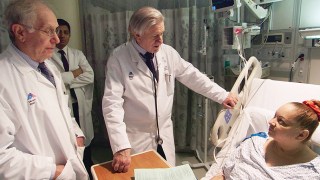Dr. Herschel Sklaroff is tending to a cardiac patient at New York’s Mount Sinai Hospital, and he’s having difficulty recording her venous pressure during a bedside exam. He asks if she is on a diuretic.
At first, Sklaroff’s Resident colleague, Dr. Robert Calenda, says “no.” But a review of the patient history quickly reveals that one of her medicines is indeed a diuretic. Sklaroff made the educated guess without looking at her chart, leaving Calenda to marvel at the veteran doctor’s ability to draw that conclusion based only on a few moments of patient interaction: “That was pretty powerful.”
That’s the first of several key moments in Making Rounds, a documentary exploring a relatively lost art in modern medicine: Listening to the patient.
The diagnostic exchange described above was more than merely an instance designed to make the senior doctor look good. It underlines the film’s thesis that accuracy and effectiveness in diagnoses are influenced as much by the experience and practice of the practicing physician as they are by advances in medical technology.
Making Rounds, directed by Muffie Meyer, makes some startling claims to emphasize the importance of bedside interviews and diagnoses. It estimates that 10-20 percent of medical cases are misdiagnosed in primary care and that the United States annually spends $700 billion on tests and procedures that “do not improve health outcomes.” During the film, Sklaroff claims that 20 percent of all diseases are caused by medicines. He and his colleagues even joke that a patient who is over 100 years old has probably managed to live so long by staying away from doctors!
It is important in such a medical landscape to ensure that physician training keeps pace with advances in medical technology. One month out of the year, Sklaroff teams with Dr. Valentin Fuster to conduct rounds at Mount Sinai. One obvious reason is to improve patient care. As Dr. Calenda observes, Drs. Fuster and Sklaroff have been practicing medicine longer than he has been alive.
Don’t over-rely on technology
But the more important goal for the senior physicians is to illustrate the importance and effectiveness of bedside interviews. “Don’t do something just because technology is available,” Fuster instructs his staff. “Today, we don’t get paid for thinking, we get paid for tests,” Sklaroff adds, pointing to a statistic that doctors with an echocardiogram machine are six times more likely to order an echo when diagnosing a patient. Is the technology being used to confirm a simpler or cheaper test, or simply out of habit? Is the collection of patient information guided by the physician’s knowledge of relevant symptoms, or simply part of a routine process that obtains as much data as possible without sifting it to glean its significance?
Sklaroff is clear that he is not anti-technology: “Nobody doesn’t acknowledge the enormous strides that medicine has taken,” he says. The point of Mount Sinai’s program is not that the technology doesn’t work, but that the people using it have to know when and how to use it.
In addition to lamenting the dependence on tests, Sklaroff also points out that increased specialization in medicine can lead to a team approach. While there are advantages to having a team of doctors, this approach can also mean that no member of the team has a comprehensive overview of the patient’s history and symptoms. This insight informs the program’s emphasis on the bedside visit. Many hospitals have doctors conduct rounds, but they do so outside of the patient’s room.
As a documentary, Making Rounds occasionally loses focus, such as when it drifts into Fuster’s biography or tries to emulate ER in making the patient stories more dramatic. Even so, it is an important explication of how medical science works and how responsible doctors are attempting to use technology rather than simply become dependent on it.
In the years prior to the filming of Making Rounds, the television drama House popularized the dictum that when it comes to medical ailments, “Everybody lies.” Sklaroff’s assertion that a bedside exam can lead to the correct diagnosis 90 percent of the time suggests that the television doctor’s dictum is not only false, but dangerous.
“Filling in templates” rather than talking to patients can lead to gaps in the medical records and alienate those patients. At times patients feel like nobody is listening because—as the film wryly observes—nobody really is. Rather than dismissing the patient as a potential source of misinformation, the documentary (and the doctors in it) argues that those patients are the first and best source of information about their symptoms.
Sometimes those symptoms can be inferred through medical tests, but bedside visits are often just as accurate while also being simpler and less expensive. The power and importance of that message—and the film’s success in conveying it—more than make up for any limitations in its filmcraft.
More research on bedside manner
Fuster and Sklaroff, the subjects of this documentary, are hardly alone in advocating for better bedside manner and doctor-patient conversations. Recent studies have shown that these issues are critical for better medical outcomes, chronic condition management, trust and patient engagement, improved patient satisfaction, and the difference between illness and health.
Good bedside patient care goes beyond the merely medical, too. The Transforming Chaplaincy project, funded by the John Templeton Foundation, digs deeper into the critical role of evidence-based spiritual care. Templeton himself said that healing is “a partnership between inner resources of mind and spirit and external scientific medicine.”
The Templeton foundation is also helping to fund research at Harvard’s Initiative on Health, Religion, and Spirituality, Duke University’s Center for Spirituality, Theology and Health, and the George Washington Institute for Spirituality and Health. All three projects explore spirituality as an essential element of health care.
Making Rounds is available to rent or purchase here. Watch the trailer below:






